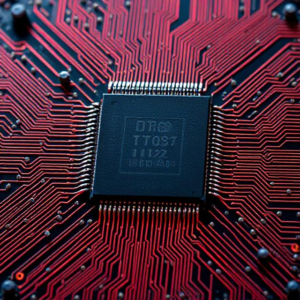1. What is a Microprocessor?
A microprocessor is often called the “brain” of a computer or any electronic device. It’s a small chip that carries out instructions to process data and make decisions. You can think of it like the control center of your computer, smartphone, or any other device that requires computing power.

2. What Does a Microprocessor Do?
The microprocessor performs a wide range of tasks, but its main job is to execute instructions that help the computer perform operations. These instructions come from software (like the operating system or apps).
A typical microprocessor can do things like:
- Calculating numbers: It can add, subtract, multiply, divide, and perform more complex math.
- Making decisions: It can compare values and make decisions based on that (like “Is this number greater than 10?”).
- Controlling other parts of the system: It communicates with other components like memory (RAM), input devices (keyboard, mouse), and output devices (monitor, printer).
3. How Does a Microprocessor Work?
A microprocessor works by following a sequence of steps known as the fetch-decode-execute cycle:
- Fetch: The microprocessor gets an instruction from the memory.
- Decode: It then figures out what that instruction means. For example, does it need to add numbers or move data around?
- Execute: Finally, it performs the instruction, whether it’s performing a calculation, controlling a device, or storing data.
4. Parts of a Microprocessor:
A microprocessor is made up of several important parts that work together:
- ALU (Arithmetic Logic Unit): This part does all the math and logic operations, like addition, subtraction, and comparisons.
- Control Unit (CU): This part controls the flow of data and instructions. It tells the ALU what to do and when, based on the instructions.
- Registers: These are small, fast storage units that temporarily hold data that the microprocessor is working on.
5. The Role of Microprocessors in Modern Computing:
Microprocessors are at the heart of nearly every modern electronic device, not just traditional computers. Here’s why they are so important:
a. Personal Computers (PCs) and Laptops:
- In PCs and laptops, the microprocessor is the main component that runs programs, loads websites, and handles everything you do on the computer. Whether you’re writing a document, browsing the internet, or playing games, the microprocessor is the one that makes all the tasks happen.
b. Smartphones and Tablets:
- Just like computers, smartphones and tablets have microprocessors that run the operating system (like Android or iOS) and apps. The microprocessor in these devices has to be fast and power-efficient because it manages a lot of tasks at once while conserving battery life.
c. Gaming Consoles:
- In gaming consoles (like PlayStation or Xbox), microprocessors are responsible for running video games smoothly. They handle complex graphics, fast movements, and interactive gameplay.
d. Smart Devices (IoT):
- Microprocessors are used in smart devices like thermostats, smart speakers (e.g., Amazon Echo), and even smart refrigerators. These devices rely on the microprocessor to process data, respond to voice commands, and perform automated tasks.
e. Embedded Systems:
- Microprocessors are used in embedded systems too. These are special-purpose computers that are built into everyday objects, such as washing machines, cars, microwaves, and medical equipment. The microprocessor controls the specific tasks these devices perform.
6. Why Are Microprocessors So Important?
- Speed and Efficiency: Microprocessors can process information extremely quickly and efficiently. This allows modern devices to perform complex tasks without slowing down.
- Miniaturization: Thanks to microprocessors, computers and electronic devices have become smaller and more portable. They pack a lot of computing power into tiny chips.
- Multi-tasking: Modern microprocessors are very powerful and can handle multiple tasks at once (called multi-core processing). This helps devices run smoothly even when running many applications at the same time.
- Versatility: Microprocessors are versatile. They can be programmed to perform many different functions in a variety of devices, making them essential for all kinds of modern technology.
7. Types of Microprocessors:
There are different types of microprocessors for different needs:
- General-purpose processors: These are found in personal computers and smartphones. They can run many different programs and are very powerful.
- Embedded processors: These are found in devices like cars, washing machines, and microwave ovens. They are usually less powerful but highly specialized to do specific tasks.
- Specialized processors: These are designed for specific tasks, like graphic processing units (GPUs) for rendering images and video.
8. The Future of Microprocessors:
As technology advances, microprocessors are getting even more powerful and energy-efficient. Innovations like quantum processors and neuromorphic processors (which mimic how the human brain works) could open up new possibilities for computing in the future.
Summary:
- A microprocessor is the “brain” of a computer or electronic device. It processes data and runs instructions from programs.
- It works by fetching, decoding, and executing instructions to perform tasks like calculations, comparisons, and controlling devices.
- Microprocessors are found in everything from personal computers and smartphones to smart home devices and cars.
- They are essential for the speed, efficiency, and versatility of modern computing devices, allowing them to run multiple tasks and applications smoothly.
Tags: ALU, applications, arithmetic logic unit, Automation, brain of computer, calculations, Cars, chip, comparison, complex operations, Computing Power, control center, Control Unit, CU, data handling, data processing, Decision Making, decode, Efficiency, electronic device, embedded processors, Embedded Systems, execute, execute instructions, fetch, fetch-decode-execute cycle, Future Technology, gaming consoles, general-purpose processors, GPUs, graphics processing units, hardware components, Input Devices, IoT, laptops, Medical Equipment, Memory, Microprocessor, Microprocessors, microwave ovens, miniaturization, modern computing, multi-core processing, Multitasking, neuromorphic processors, Operating System, output devices, permanent storage, Personal Computers, Power Efficiency, quantum processors, RAM, registers, Smart devices, smart speakers, Smart Technology, smartphones, Software, specialized processors, speed, tablets, task management, temporary storage, thermostats, user interaction, versatility, washing machines


